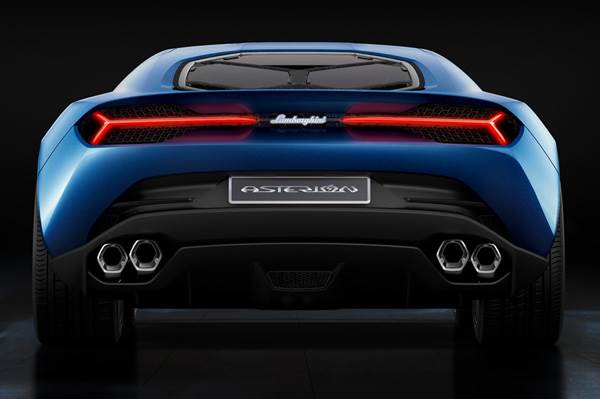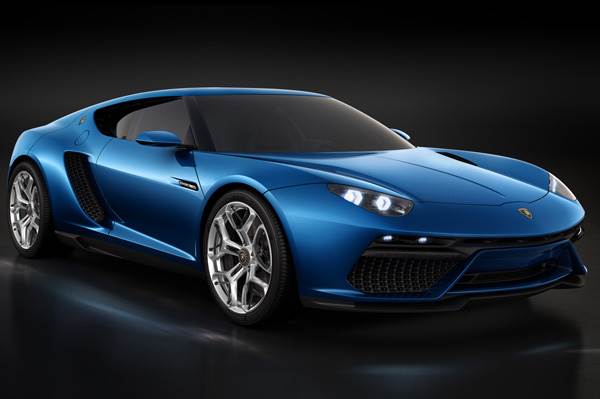Lamborghini has unveiled a new one-off concept, dubbed Asterion, on the eve of the Paris motor show. The model is described as a "technology demonstrator" which shows off an in-house-developed, 898bhp plug-in petrol-electric hybrid drivetrain.
Described as having a "unique Lamborghini cruising experience together with everyday urban drivability", the concept is capable of travelling on electric power alone for up to 50km.
The multi-faceted Asterion LPI910-4 was unveiled by Lamborghini president Stephan Winkelmann at a media event prior to the Paris show.
Being careful to distance the new Lamborghini concept from the existing crop of petrol-electric hybrid powered hypercars such as the LaFerrari, McLaren P1 and Porsche's 918 Spyder, Winkelmann described the Asterion LPI910-4 as being “conceived more for comfortable luxury daily cruising than for ultimate track performance”.

Power for the new two-seater hails from Lamborghini’s first ever plug-in petrol-electric hybrid drivetrain – a unit heavily tipped to make its debut in a production version of the Urus, which, despite official claims suggesting it still awaits an official go-ahead from parent company Audi, has already undergone extensive conceptual development at the company’s Sant’Agata headquarters, according to Audi sources.
The advanced hybrid drivetrain is based around the latest evolution of the Italian supercar manufacturer’s naturally aspirated 5.2-litre V10 petrol engine, as used by the recently introduced Huracan.
On its own, the longitudinally mounted V10 delivers 602bhp exclusively to the rear wheels via a seven-speed dual-clutch automatic gearbox which is located behind the engine in a traditional transaxle layout.
The petrol engine is combined with three brushless electric motors – one placed within the gearbox and capable of directing drive to the rear wheels, and two more powerful units situated within the front axle, where they provide direct drive to the front wheels.

Together, the electric motors produce a combined 296bhp, raising the Asterion's overall output to 898bhp and a yet to be specified peak torque figure.
The driver can choose between three driving modes via buttons on the steering wheel. Included is 'Z' for zero local-emission running, 'I' to select Ibrido (the Italian word for hybrid) and 'T' denoting Termico, meaning thermal power.
Energy used to power the three electric motors is stored in a lithium ion battery mounted down the centre of the cabin within the tunnel usually reserved for the gearbox – a layout Lamborghini claims helps provide its latest concept with best possible combination of balance and crash safety. The battery can be charged either via recuperated means while on the run or on mains power via a conventional wall socket.
In front-wheel-drive electric mode, the Asterion is claimed to possess a range of up to 50km at speeds of up to 125kph. In hybrid mode, in which the individual power sources simultaneously channel drive both to the front and rear wheels, the new Lamborghini is claimed to possess a 0-100kph time of 3.0sec and a top speed of 320kph.
In keeping with developments seen on the Huracan, the Asterion LPI910-4 is based around a carbonfibre monocoque and clothed in a carbonfibre composite plastic body. Lamborghini has not revealed a kerb weight for the new car but the electric components and lithium ion battery used within the hybrid system weigh are claimed to weigh 250kg in total.

Styled under the guise of Lamborghini design boss Filippo Perini, the Asterion LPI910-4 provides the first tacit clues of how the Italian supercar manufacturer aims to progress the look of future models, including the production version of the Urus.
The exterior eschews the sheer surfaces and inherent edginess of recent Lamborghinis for fuller and more curvaceous forms. There is also a smoother transition between the various panels than on current models for a more flowing form and slender appearance overall.
The most controversial feature of the new car is the styling of the front end, which appears to take inspiration from another classic Italian supercar, the De Tomaso Pantera. It is combined with a rear end that takes many of its cues from the new Huracan.
The leading edge of the bonnet sits higher than that of any current Lamborghini model in a move Perini says is part of efforts to provide the Asterion LPI910-4 with greater everyday drivability, by providing a clear point of reference for the driver during parking maneuvers and city driving.
The windscreen is also more upright than on any recent Lamborghini in an effort to ease entry to the cabin and provide increased headroom. The space behind the seats is used as a luggage compartment.
Among the developments brought to the exterior is an active cooling system. Incorporated within the front air intakes, it uses a double-layered grid in which metal and titanium are embedded into each other, the former containing a Y-shaped mesh and the later a hexagonal theme. A transparent engine cover is comprised of three panes of glass that change their position according to the driving mode.
As with the exterior, Lamborghini has used the interior of the Asterion to explore new design and packaging themes. The minimalistic dashboard is said to provide hints to future models, while the seats are mounted higher than those in existing Lamborghinis for what Perini describes as “comfortable everyday cruising rather than extreme handling”.
Sticking with Lamborghini tradition, the Asterion takes its name from that of a mythical bull. The LPI910-4 suffix can be broken down into four elements – 'LP' for the Italian 'longitudinal posteriore' that denotes a longitudinal rear mounting of the petrol engine, 'I' stands for 'ibrido', '910' is the car’s overall output measured in metric horsepower and the '4' signifies four-wheel drive.






Comments
Member Login
Personal Details
No comments yet. Be the first to comment.